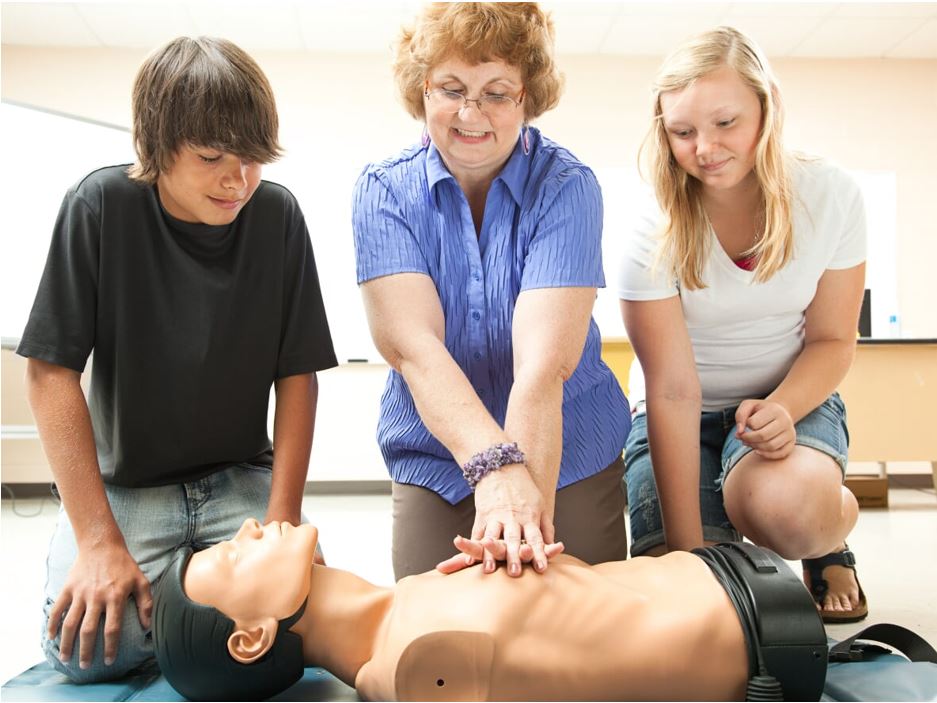The story of two boys saving their grandma from death using CPR skills their mother taught them is an amazing feature, and further proves that even with just a little training, all can save lives no matter what age or size.
At Coast2Coast, we encourage all to be trained in CPR, including children. We hope these few tips can encourage parents to be trained in CPR and help their children learn the importance and skills to be life-savers.

From a 2009 study by Dr. Fritz Sterz at the Medical University of Vienna, approximately nine out of ten children (aged 9 to 18) performed the skills correctly, although only 69% correctly performed mouth-to-mouth resuscitation. This indicates that hands-only CPR may be more effective for children to learn.
The first step is to have the parent or guardian be certified in CPR. Coast2Coast offers an array of class choices, such as re-certification for those already certified, or online blended for those who are comfortable with online learning for theory and in-class learning for practical skills.
Once certified, you can begin to teach your children the correct procedures of CPR. Studies have shown it is it’s best to keep it simple by teaching hands-only CPR, without the rescue breaths.
The two steps that are very important are
- Teaching them to call 911
- Teach them to perform chest compressions
Letting your kids know about the significance of 911, and that it is for serious emergencies only, will help them understand that if there is an emergency, and no adult is around, they can rely on 911 for help and guidance.
From as early as the toddler stage, it is good to teach your children your full name, and if you have a partner/spouse their full name, address, and phone number. 911 dispatchers do have access to finding the location of the emergency call, but emergency workers will be able to arrive faster and at the exact location with the correct address.
Letting your child know they can trust 911 dispatchers is very important, as they might ask questions they have been previously told not to tell strangers. 911 dispatchers should be treated like doctors and police officers; they are here to help you, not to hurt.

Get Trained Anytime, Anywhere!
Join our Online Blended First Aid Training and learn essential life-saving skills at your convenience. With a mix of online modules and hands-on practice, you’ll be fully prepared to respond to emergencies.
The next step is performing chest compressions. Show your kids that when performing chest compressions, they need to press hard in the center of the victim’s chest, to the tune of such songs as “Sorry” by Justin Bieber, “Closer” by The Chainsmokers, “Crazy in Love” by Beyonce, or any song they can recognize that has 100 beats per minute.
With these two steps, they have bought time to help save a life before emergency personnel come to take over.
If your youngsters have confidence in their teaching, you can demonstrate the different way to perform compressions on other children and infants. For infants, only two fingers are needed, and children only require pressing down with two inches. Explain that the neck is a special part of the body and should be treated as such, as they do not want to cause head or neck injury as well. For pre-teens, we offer a babysitting course, where the instructor fully demonstrates CPR with age appropriate teaching methods and practice.
Another step that can help children comprehend CPR is to introduce life-saving equipment to them, and to show where they are kept in a house, church, sports facility, school, etc. These can include but are not limited to face masks, inhalers (for asthmatic persons), mats for kneeling, and AED’s. Our store at Coast2Coast First Aid has all the products you would need to keep you and your family safe.

The first few minutes are critical to saving a person’s life. Buying time before medical personnel arrive on the scene can be a life-altering decision of life and death. These boys in the article saw their grandma in crisis, and acted accordingly because of their mom’s training for CPR. Children are more than capable of learning CPR techniques and being guided in how to handle an emergency when given the tools and confidence by parents and guardians.
Coast2Coast courses cover essential CPR/AED and first aid knowledge, that can be translated into real life emergency situations. With our courses, you will be self-reliant in emergencies; with passing this information on to your children, you can be assured that if a day ever comes they need to use their proficiency in CPR, they will be ready.
Enroll in a CPR class with Coast2Coast First Aid to have you and your family safe and sound for any disaster!
Register for First Aid Training
Register today for a First Aid Training course and learn how to deal with emergencies and keep your loved ones safe! Check out our facilities and book your spot now.




















No comment yet, add your voice below!